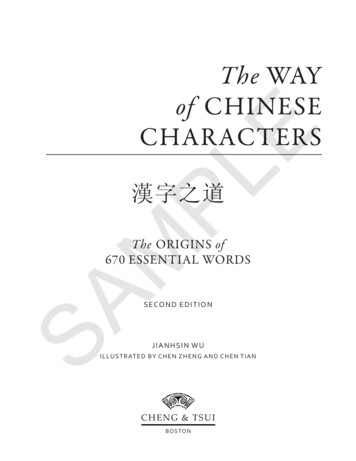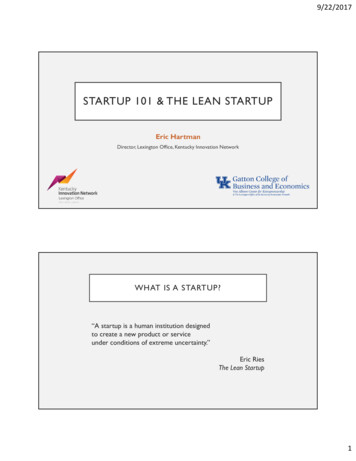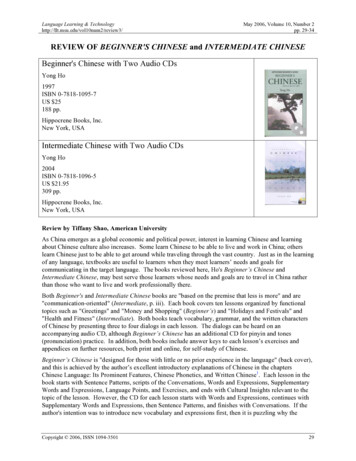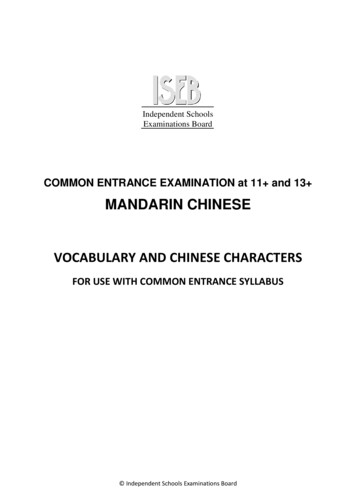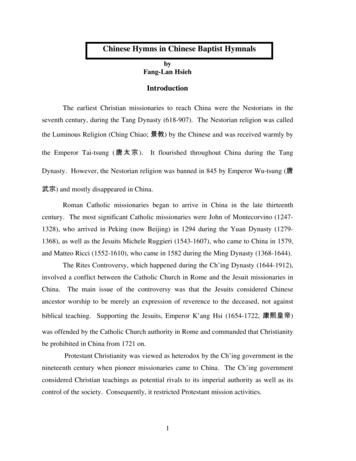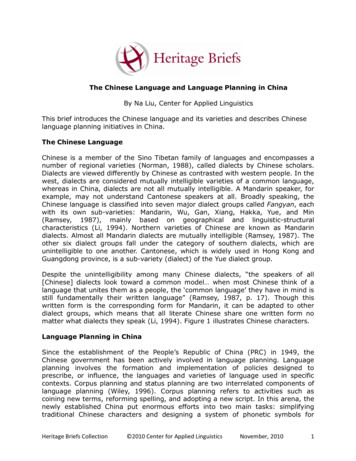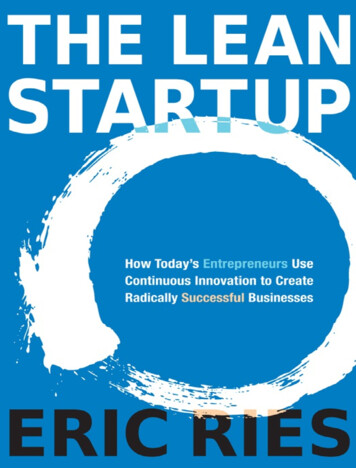
Transcription
STARTUP BUSINESSSAMPLEChineseSBC3-Frontmatter.indd i2013/9/25 19:09:39
Cheng & TsuiPublications of Related InterestPLECheng & Tsui English-Chinese Lexicon of Business Terms (with Pinyin)Comp. by Andrew C. ChangA unique lexicon designed to satisfy the special needs of English-speaking learners. All words andphrases include pinyin romanization along with Chinese characters.Open for Business: Lessons in Chinese Commerce for the New MillenniumBy Jane C. M. KuoA top-selling two-volume set of intermediate to advanced level textbooks for business Chinese.MClose the Deal: Advanced Chinese for Creative and Productive BusinessBy Yu Feng, Xiaoxue Dai, and Miranda Chen-CristoforoUsing the ‘case study’ method, this task-oriented book approximates real-world ventures ine-commerce, mergers, intellectual property rights.SAChinese Odyssey: Innovative Language CoursewareBy Xueying Wang, Li-chuang Chi, and Liping FengA multimedia-based, three-year series for learning Chinese. Multimedia software, textbooks,workbooks, and audio CDs are available.Success with Chinese: A Communicative Approach for BeginnersBy De-an Wu Swihart, et alA practical set of four volumes for those needing to manage the essentials of everyday living inChina. Divided into Listening & Speaking and Reading &Writing volumes.Integrated ChineseThird EditionBy Yuehua Liu, Tao-chung Yao, et alThe bestselling introductory college-level series for learning Chinese. This series includes books,workbooks, character workbooks, audio products, multimedia products, teacher’sresources digital eBooks, online textbooks and workbooks, and more.Please visit www.cheng-tsui.com for more information on these and many otherlanguage-learning resources.SBC3-Frontmatter.indd ii2013/9/25 19:09:39
STARTUP BUSINESSPLEChineseMLevel 3SAAN INTE RME DIATE -HIGH COURSEF OR P ROFE SSIONALSኆး૩ Ꭽ Ꮩᓠॳ છ੪ ྱJane C. M. KuoCHENG & TSUI COMPANYBostonSBC3-Frontmatter.indd iii2013/9/25 19:09:39
PLECopyright 2014 by Cheng & Tsui, Inc.All rights reserved. No part of this publication may be reproduced or transmitted in any form or by any means,electronic or mechanical, including photocopying, recording, scanning, or any information storage or retrievalsystem, without written permission from the publisher.20 19 18 17 16 15 14 131 2 3 4 5 6 7 8 9 10First edition 2014SAMPublished byCheng & Tsui Company, Inc.25 West StreetBoston, MA 02111-1213 USAFax (617) 426-3669www.cheng-tsui.com“Bringing Asia to the World” TMISBN 978-1-62291-0304All logos and references mentioned in this textbook are used for identification purposes only and are theproperty of their respective owners.Printed in the United States of AmericaSBC3-Frontmatter.indd iv2013/9/25 19:09:40
Publisher’s NoteProfessor Shou-hsin Teng, Chief EditorChair Professor, Dept. of Chinese as a Second LanguageChungyuan Christian University, TaiwanProfessor Samuel CheungDepartment of ChineseChinese University of Hong KongPLProfessor Dana Scott BourgerieDepartment of Asian and Near Eastern LanguagesBrigham Young UniversityEThe Cheng & Tsui Asian Language Series is designed to publish and widely distributequality language learning materials created by leading instructors from around the world.We welcome readers’ comments and suggestions concerning the publications in this series.Please send feedback to our Editorial Department (e-mail: editor@cheng-tsui.com), orcontact the following members of our distinguished Editorial Board.SAMProfessor Ying-che LiDept. of East Asian Languages and LiteraturesUniversity of HawaiiProfessor Hong Gang JinDepartment of East Asian Languages and LiteraturesHamilton CollegeFormer members of our Editorial BoardProfessor Timothy Light (emeritus)Western Michigan UniversityProfessor Stanley R. Munro (emeritus)University of AlbertaProfessor Ronald Walton (in memoriam)University of MarylandSBC3-Frontmatter-rev.indd 59/26/13 9:29 AM
PLEMSASBC3-Frontmatter.indd vi2013/9/25 19:09:40
ContentsixAcknowledgementsxiList of AbbreviationsxiiLesson 1 ᑾຨධ၌ Job InterviewLesson 2 ᏽচषಟ Lesson 3 ݾ ܓ Lesson 4 Ⴇಕ Lesson 5 ܖ চ ݑ Lesson 6 ᓚ PLEPrefaceLesson 7 ኡ Lesson 8 119Cantonese Dining43Gift Giving67Factory Touring91Quality Control115Vacationing135क़୶ ڀ ᔢ Packaging157Lesson 9 ቜၓཐ Sales Distribution177Lesson 10 ᒩਧট Supply Chain Integration199Lesson 11 অჴ Price Negotiation225Lesson 12 ༾জግ Celebratory Banquet243SAMEmployee BenefitsAppendices1.2.3.4.5.SBC3-Frontmatter.indd viiEnglish Translations of the Dialogues261Additional Listening Comprehension Exercises271Chinese-English Glossary299English-Chinese Glossary317Index of Sentence Patterns3352013/9/25 19:09:40
PLEMSASBC3-Frontmatter.indd viii2013/9/25 19:09:40
PrefacePurpose of Startup Business ChinesePLEAfter the implementation of the Open Door policy, China has become a dominant force in globalbusiness, competing with other economic superpowers like the U.S. and Japan. As China’s businessdevelopments continue to expand, transform, and urbanize, opportunities for foreigners to work or dobusiness in China will abound for decades to come. Understanding the Chinese language and culturehas become an important professional business tool to work with. The Startup Business Chinese series isdeveloped to serve this exact purpose. This textbook is the third level in the series.Startup Business Chinese 3 is designed for students and business professionals who wish to acceleratetheir language proficiency with a business focus, so that they can acquire essential communication skillsand consequently conduct business more effectively in China.SAMIt is the author’s hope that through practical and situational dialogues on relevant business topics, whichinclude industry and workplace-specific vocabulary and expressions, learners may become betterequipped to interact with their local colleagues, employees, and clients in China. Business-relatedcultural points are discussed to facilitate understanding of the necessary Chinese regulations, socialcustoms, and protocols. Overall, interactive communication skills are prioritized to enable learners toreach beyond an intermediate level of Chinese language proficiency in a reasonable amount of time.Features of This BookLearning ObjectivesSimilar to Startup Business Chinese Level 2, each lesson begins with key points outlining what studentsare expected to learn.Situational DialoguesThis textbook consists of 12 lessons. Each lesson has a dialogue based on a storyline. Using StartupBusiness Chinese Level 1 and 2 as a foundation, the text features a narrative passage, followed by adialogue in each lesson. The dialogues aim to provide students with an authentic business conversationin both context and content. Students will be able to apply these dialogues to real-life businesssituations.The dialogues from each lesson are presented in two forms: simplified Chinese characters and, in thebox underneath, pinyin Romanization. Students are encouraged and expected to read the Chinesedialogue without the aid of the pinyin, and should refer to the pinyin only when necessary. The authorPrefaceSBC3-Frontmatter.indd ixix2013/9/25 19:09:40
understands that some teachers may choose not to emphasize character writing, and therefore provides the pinyin forstudents who have not been trained in writing Chinese characters.VocabularyThere are a total of 686 new words, which introduce students to terms that are used in day-to-day operations, and withbusiness partners at social events.Each lesson features two vocabulary lists. The first list contains words that appear in the lesson’s dialogue, andimmediately follows the pinyin dialogue. The second list, labeled Additional Vocabulary, includes words usedthroughout the rest of the lesson in the Sentence Patterns. This list precedes the Sentence Patterns section. Words inthe Additional Vocabulary section are terms that are used both in the business environment and in everyday life.Additionally, simplified and traditional characters are presented in juxtaposition, along with indications for words withmore than one expression and pronunciation.Sentence PatternsPLEEach lesson dialogue introduces relevant sentence patterns and new words. The patterns are explained in clear languagebased on structure and usage. Both formal and informal business usages are included in examples. In addition, mostexamples are presented in a mini-dialogue format to ensure that the reader will learn the accurate semantic usage andimprove their communication skills. Each sentence has its own English translation for self-study, immediatelyaccompanied by a Practice Section for further opportunities to master the pattern.Cultural PointsMWhile Startup Business Chinese Level 1 and Level 2 provided students with a convenient side-by-side Chinese text andRomanization guide, Startup Business Chinese Level 3 minimizes this dependence on Romanization, only providingpinyin for new words. Every lesson has a large amount of vocabulary; this is intended to provide learners withopportunities for sustainable self-study.SAGiven that culture is an integral part to learning any language, each lesson includes key cultural notes in the dialogues,sentence examples and vocabulary. Though most notes are embedded in the dialogues, a separate cultural point is alsoincluded in each lesson. These cultural points highlight important aspects of business practices in different regions inChina, giving learners a deeper understanding of various Chinese business cultures, which promoteinterpersonal relations and overall socio-cultural competence.Downloadable AudioThe textbook includes access to supplementary online audio materials, with all of the dialogues, vocabulary words,and sentence patterns. Audio files facilitate development of accurate pronunciation and listening comprehensioninteractively. Authenticity, accuracy and quality of pronunciation are ensured, as the speakers on the files are all nativeChinese speakers. You can download these audio files at www.cheng-tsui.com/downloads.ExercisesAdditional practice exercises based on the main dialogues, vocabulary, and sentence patterns can be found at the end ofeach lesson. This practice material provides a variety of exercises to sharpen communication skills through reading,writing and listening comprehension with the audio downloads described above. Through a function-based approach,the exercises progress from simple questions and tasks to more complicated, open ended questions focusing on thecontent of the lesson. The exercises also emphasize building up one’s vocabulary, knowledge of grammar, and thelesson’s subject matter, with an ultimate focus on cultivating high level communication abilities.xStartup Business Chinese 3SBC3-Frontmatter.indd x2013/9/25 19:09:41
AcknowledgementsI would like to thank the following people for their encouragement, support, and assistance. Their effortmade it possible for me to complete the third volume of Startup Business Chinese series.First of all, I would like to thank the team at Cheng & Tsui, especially the President, Jill Cheng, for herunwavering confidence in me as I publish my fifth book with her company. I would also like torecognize Phoenix Tso, Editorial Assistant, as well as the rest of the staff, for their patience and hardwork in helping me produce this book.PLESecondly, my sincerest appreciation goes out to Joy Wu, Angela Lee, Jin Zhang, Xiaoxiao Fan and XinkeSun from the University of California, San Diego. These individuals’ outstanding contributions haveassisted me in completing this book without delay. My gratitude also goes out to Sylvia Li, who spentmany hours proofreading the final version.My special thanks go to Dr. Pamela Radcliff, Chair of the History Department at the University ofCalifornia, San Diego, for providing me with a grant to conduct research for this book in China, and totake photos for it as well.SAMLastly, I thank my father (who regretfully passed away while I was working on this project) and mymother for their affection, encouragement, and understanding, and my husband for his acumen,inspiration, and all-encompassing support.AcknowledgementsSBC3-Frontmatter.indd xixi2013/9/25 19:09:41
List of AbbreviationsAbbreviations for Parts of SpeechAdjAdjectiveAdvAdverbAVAuxiliary onjInterrogative PronounMMeasure efixPrepPrepositionSAOSSubjectSufSuffixTTime wordIEIdiomatic ExpressionVVerbVOxiiVerb plus ObjectStartup Business Chinese 3SBC3-Frontmatter.indd xii2013/9/25 19:09:41
Lesson 1ᑾຨධ၌SAMPLEJob InterviewObjectivesIn this lesson we will learn: How to answer some common interview questions. How to familiarize ourselves with interview etiquette. How to respond to different types of interview questions.SB3-1-Lesson 1.indd 12013/9/23 16:40:32
Dialogue ߚਥٛᎺᄨᐦࣻ ଗධੋĶಒᓎශ ൕ ᨛ ٛᎺᄨড႘࠲ᆖጻĶࢤვඑ࠲ড႘ । མĶდ ܖ ૯ ড႘࠲ᑾຨછĶ۪༤࠱ࠫ ࡈ ߚධ၌࠲ �ᓎශධჴiSAMPLEᆓຂń ฏ ဿಒᓎශٍʼn༽ᕪiཿ် ܇ ᅆᒺฏ࠲ဩ Ķ ฏႏ ཷฏᐥౘড႘ፃᄇ࠲ᏹ፺ٍʼnಒᓎ ශń ᆓᕎĶฦਛīཿ် ܇ ��ဪൾᏹ፺iᆓຂń ဿᒐጟ࠲Ķᇒඑᒐߚᔇጲဿቍᑾຨ ঊਧ၂࠲ᔇ ᔊ Ķ૯༑ፃሤঋঊ ܇ ඏ࠲ᓠ ܫ iಒᓎශń ᇒཙ ܖ ૯ᑾຨછ࠲ဩ Ķཿ် ࠲܇ झ ᇒႏ Ķდ ᇒ ຨቜၓ ࠲܇ ᔊ iᆓຂń ఋဿฏ෯࠲ဿ၈ ቜ࠲႐့ውᆻĶᒃ ႏ၈ ࠲܇ চᕩঐ၂ਧฏ إ iಒᓎශń ࠲ཫဿᒐጟiఋဿᇒጺ ቍᎺ છષ ፃቭᓁ ޱ ఏ ࠲ ጏiᆓຂń ୯ᄨཷฏౘĶ ဿቍ ฏফᅆፃሤiড႘ യٕฏ ض ๓ࠫ၈ ܇ ཙĶฏ ၔ൘ʼnಒᓎශń ෳ၈ ܇ ᔊ ᔇጲॎᐼ ቭচᕩคʼnᆓຂń ᒐঊᓀᆻާ ፃቭၵ ईᇶ࠲চᕩ ᆀĶᎺဩ ጺኬጲ ఏ ޔ iಒᓎශń ໔ိᒐጺ ୍ڮ भਧᇒ࠲ མĶᇒሔੰਥఏ ହ iᆓຂń ਛ࠲Ķෳࠉછ ၈ ܇ ᔇ છᐥ i2Startup Business Chinese 3SB3-1-Lesson 1.indd 22013/9/23 16:40:34
PinyinShàng cì hé Bái Yǒutiān zài fēijī shang jiàn miàn hòu, Lǐ Zhìmíng jiù mǎshàng liúlǎn le Bái Yǒutiān gōngsī dewǎngyè, duì tāmen de gōngsī hěn gǎn xìngqù, suǒyǐ cānjiā le gōngsī de zhāopìnhuì, bìngqiě dédào le dì-èr cìmiànshì de jīhuì. Zài huìyìshì li, gōngsī fùzǒng Wáng Péng zhèngzài hé Lǐ Zhìmíng miàntán.Nǐ jiù shì Lǐ Zhìmíng ba? Qǐng zuò. Rénshìbù tōngzhī nǐ de shíhou, gēn nǐ shuō le ràng nǐ zài láigōngsī yí tàng de yuányīn ba?Lǐ Zhìmíng:Wáng Zǒng, nín hǎo! Rénshìbù zhǐshì tōngzhī wǒ jīntiān lái jiàn nín, bìng méiyǒu gàosu wǒ shìshénme yuányīn.Wáng Péng:Shì zhèyàng de, wǒmen zhè cì zhǔyào shì xiǎng zhāopìn jǐ gè héshì de zhǔguǎn zhùlǐ, jiāqiángyíxià gège bùmén de zhōngcéng guǎnlǐ.Lǐ Zhìmíng:Wǒ qù cānjiā zhāopìnhuì de shíhou, rénshìbù de Féng Jīnglǐ gēn wǒ shuō le, suǒyǐ wǒ juédìngyìngpìn xiāoshòubù de jīnglǐ zhùlǐ.Wáng Péng:Kěshì nǐ ná de shì shìchǎng yíngxiāo de shuòshì xuéwèi, zhàolǐshuō shìchǎngbù de gōngzuògèng shìhé nǐ a.Lǐ Zhìmíng:Díquè shì zhèyàng. Kěshì wǒ yě hěn xiǎng yǒu jīhuì jīlěi yìxiē zhíjiē jiēchù kèhù de jīngyàn.Wáng Péng:Jīntiān ràng nǐ lái, jiù shì xiǎng gēn nǐ gōutōng yíxià. Gōngsī kǎolǜ bǎ nǐ ānpái dào shìchǎngbùqù, nǐ kěn jiēshòu ma?Lǐ Zhìmíng:Nà shìchǎngbù jīnglǐ zhùlǐ zhǔyào fùzé nǎxiē gōngzuò ne?Wáng Péng:Zhège zhíwèi chúle yìxiē shùjù fēnxī de gōngzuò yǐwài, yǒushíhou yě xūyào gēn kèhùyìngchóu.Lǐ Zhìmíng:Qíshí zhè yě bǐjiào fúhé wǒ de xìngqù, wǒ xǐhuan hé kèhù dǎ jiāodào.Wáng Péng:Hǎo de, nà dāi huìr shìchǎngbù zhǔguǎn huì zài gēn nǐ miàntán, tā huì xiàng nǐ shuōmíng jùtǐde gōngzuò qíngkuàng.SAMPLEWáng Péng:VocabularyTraditionalPinyinPart itment fair; job fairdédàoVto obtain; to receivemiànshìN/Vinterview; to interview for a job or a positionfùzǒngNvice-president of a companyWáng PéngPNධჴᄇ۪面談趟並miàntánV/NWang Peng (the full name of a fictionalperson in this text)to interview (face-to-face); job interviewtàngMmeasure word for a tripbìngAdvactually (used to reinforce a n 1 Job InterviewSB3-1-Lesson 1.indd 3ᑾຨධ၌ 32013/9/23 16:40:35
TraditionalPinyinPart ofSpeechEnglish૯༑ᓠ ܫ झ ຨᒃ ႏ၂ਧ࠲ཫષ āqiángVto reinforce; to strengthenzhōngcéngNmiddle-level; middle-rankingFéngPNFeng (a surname)yìngpìnVto accept a job offerzhàolǐshuōAdvlogically speaking; theoretically speakingshìhéVto fit; to suit; to be suitable fordíquèAdvindeed; reallyjīlěi/lěijīVto accumulate; .16. ޱ 接觸jiēchùV18.ফᅆ ၔॎᐼ溝通肯接受負責gōutōngV/Nto come into contact with; to engage(with people)to communicate with; communicationkěnAVto be willing tojiēshòuVto �iNshùjùNdata; numbersfēnxīN/Vanalysis; to analyze25.ᓀᆻၵ ईᇶ ହ to be responsible; to take responsibility for;conscientiousposition; postdǎ jiāodàoVO26.ிᄡ具體jùtǐAdj20.21.22.23.to have dealings with; to make contacts with(to come into contact with)exact; concrete; specific; definiteSA24.M19.PLE17.4Startup Business Chinese 3SB3-1-Lesson 1.indd 42013/9/23 16:40:35
Additional VocabularyNote to students: These additional vocabulary items can be found in the Sentence Patterns and Practicesections of the lessons.PinyinPart ofSpeechEnglishཫ ཿၵओॏᄴ ܣ ੵ జ ܍ Ꭿኧ �事會quèdìngV/Adjto determine; to make surerénshùNnumber of people3.fēngfùAdjrich; abundant; plentiful4.tiào cáoVOto change a job5.huànVto change; to exchange6.lāVto pull; to draw (in)7.kǒucáiNeloquence8.yōuxiùAdjoutstanding; excellent9.dǒngshìhuìN ۆ Vboard of directors(in an enterprise)to compile; to edit10.11.shíxíshēngNintern12.nénglìNability; yòngVto employ; to appoint to apositionto �ྂ嚴格投勝任yángéAdjto hold back in doubt orindecision; to hesitatestricttóuVto send (a resume); to submitVୠຨཿ ॳ ܫ 解聘人選高層shèngrèn (PRC)/shēngrèn (TW)jiěpìnVto be competent; to be qualifiedfor (a job)to dismiss an employee; to firerénxuǎnNcandidate; applicantgāocéngNhigh levelSA1.PLETraditionalSimplifiedLesson 1 Job InterviewSB3-1-Lesson 1.indd 5ᑾຨධ၌ 52013/9/23 16:40:36
Sentence Patterns1:并没有告诉我是什么原因。۪ is an adverb used in a negative sentence to emphasize the point being made. It is always used witheither ܃ or අᎺ.۪ negative sentenceSample Sentences1.rénshùPLEquèdìngཿ် ܇ ፙ ૢ੨ጲᑾຨᏽচĶ࠙ဿ۪අᎺཫ ிᄡཿၵiThe HR department has planned to recruit workers, but has not decided on the exact number.fēngfù2. Ⴞ ฏ ᒐ಄ᇊᄞ࠲ ጏ ओॏĶ࠙ဿᒐଚ်۪ ܃ ቓฏቍ࠲ෳൾྑ፟iMAlthough you have plenty of experience in handling this type of problem, this matter is notas easy as you think.tiào cáoSA3. A ฏᆪဪൾጲᄴ ܣ คʼnᇒඑড႘࠲চᔼ۪ إ࠻܃ ʼnWhy did you want to switch companies (lit. jump ship)? Our company’s salary is not that low. huànB: ۪ ܃ lary was not the issue; I just wanted a change of environment.PracticeInsert ۪ into the correct place in the following sentences:61. ܃ ဿᐦ၈ ܇ চᕩ Ꮊ છ ޱ ఏ i2.ཿ် ܇ Ⴞ ٰড၊ ୍ڮ Ķ࠙ဿᓀᏽඅᎺ၈ ࢰ࠲܇ i3. ࢰඊৰཿ໔ိ ܃ ቓᓠৰཿෳൾሔੰ௪ OKiStartup Business Chinese 3SB3-1-Lesson 1.indd 62013/9/23 16:40:37
2:的确是这样。࠲ཫ has the following usages:When ࠲ཫ is used as an adverb to confirm a statement, it means “really,” “surely,” or “indeed.”Sample Sentenceslā1. A:ᒐঊᐎვᏀ ঊ ఏ iHe has brought in three big clients again this month.B:PLEkǒucáiቓვෳൾᎺజ ࠲܍ ཿ࠲ཫ ၂ਧᕨቜၓচᕩiThe sales job would certainly suit an eloquent person like him.yōuxiù2. A:ཿ် ࠲܇ ᔇ ႏኆᑾຨ࠲ᒐ ᆻ ᔊ ᎯኧĶฦ ࠱ᑁൾጟʼnMThe HR director said these newly hired assistant managers are quite outstanding, what do you think?dǒngshìhuìB: ვඑ࠲ཫ จढ़Ķ ်છࢤვඑጺ ൢ፪iSAThey are indeed very capable, and the board is very satisfied with them.biān3. A:ᒐ ڤ ጽᐟᓎ࠲ཫ ࠱ۆ ਛĶާ ሄᄔۖࢰ ᆀĶੳᎺ ਛ࠲၈ ၵ ईᇶiThis business magazine is indeed well-compiled, besides an abundance of information, there aremany good market data analyses.B: ৌቜၓ ᒐൾॳคiNo wonder the sales volume is so high.Lesson 1 Job InterviewSB3-1-Lesson 1.indd 7ᑾຨධ၌ 72013/9/23 16:40:37
࠲ཫ can also be placed at the beginning of a sentence, followed by a comma, to express firm agreementwith a previous statement. ࠲ཫဿ or ࠲ཫဿᒐጟ is a common expression, as seen in this book.Sample Sentencesshíxíshēng1. A:nénglì୯ᄨᐳ ౘධ၌࠲ᒐೃঊိሒတ ౘ ቂࠟᎺจಬĶᒔ࠲ pìnyòng ॗຨᎭ ፃঊi The two interns who came for the interview this morning seemed very capable;gùyòngB:PLEit’s difficult to decide which one we should hire.࠲ཫĶᇒඑᓋจৃᎭፃঊཿĶᒐঊ ᒔ࠲ ᕨiIndeed, we can only choose one, so making this decision is in fact very difficult.2. A: ٤ဩ Ķ ٩ ཷ܃ ᇒඑᎭೊᄨচிĶႏછყࠐᇳচᕩiWhen we’re at work, the boss doesn’t let us use online chat tools; he said they impede productivity. ٤࠲ဩ ਥກᎻೊᄨ࠲ཫყࠐᇳচᕩ iMB:Using work hours to chat with friends will certainly affect that.yóuyùSAA: ࠲ཫဿiᑁൾ ᒐঊᇊᄞĶ໔ိ ٩ጺᎶᏱiVery true. As for dealing with this issue, the boss is in fact indecisive about it.3. A: ᇒඑࣔሸᕠ ࠲ࠫރ ཿᄔۖࢰiWe have noticed that there are quite a few people who are arriving late, recently.yángéB:࠲ཫဿᒐጟĶდ ཿ် ࠲܇ ॗጲঐድঅፃࡑiIndeed. Therefore, I think the HR department’s management should be a little more strict.PracticeInsert ࠲ཫ into the correct place in the following sentences:81.ฏۖৌვĶBBBBᒐଚ်ვBBBBጺ ި༷܃ i2.ᒐߚ࠲ᑾຨછBBBB ጏओॏ࠲ཿBBBB ࢰ܃ iStartup Business Chinese 3SB3-1-Lesson 1.indd 82013/9/23 16:40:38
Complete the dialogue using ࠲ཫ and the words given in parentheses:3. A: ᇒࣔሸజ ܍ ਛ࠲ཿ۪ ܃ ፃ ၂ਧᕨቜၓiB: BBBBBBBBBBBBBBBBBBBBBBBBBBBBiIJ ጏĶ ହ ij4. A: ฏ࠱ࠫᒐঊධ၌ છᒔ ྑ܃ ፟iBBBBBBBBBBBBBBBBBBBBBBBBBBBBiIJᔮ ڞ Ķᅔ ��PLEB:ᒃ ႏ or ᒃ is an adverb meaning “logically speaking.” It should be placed at the beginning ofa sentence which states the reason or judgment. ఋဿ or ࠙ဿ can be used in the second clause toreinforce the tone of transition.Sample Sentencestóuვᅔ ෳൾࢰ ಞĶᒃ ႏ ॗછᎺፃೃ૮ড႘ঌვ ै إ iM1.He has submitted so many resumes; logically speaking, there should be one or two companies who willreply to him.SA2. A: ᒃ ႏĶ ቜ ܇ ॗॎᐼᒐঊቐ෫Ķఋဿ ܃ ᒺ ᆪဪൾ ཨ ၈ ܇ ॎᐼiLogically speaking, the sales department should be responsible for this project, but I don’t know whythe manager asked the marketing department to take responsibility.shèngrènjiěpìnB: ፺ᆪ ቜ ܇ ࢰཿ ܃ จလྂচᕩĶ ୠຨ ࢰཿĶდ ვඑ࠲ཿ၎ ܃ iBecause there are many unqualified people in the sales department, the manager fired a lot of them,so the sales department is shorthanded.A: ไĶᏹౘဿᒐጟiOh, so that is why.Lesson 1 Job InterviewSB3-1-Lesson 1.indd 9ᑾຨධ၌ 92013/9/23 16:40:39
PracticeComplete the following sentences with ᒃ or ᒃ ႏ:1.ვષ ෳൾࢰ၈ ቜ࠲ ጏĶ BBBBBBBBBBBBBBBBBBBBBBBBi2.ვࢤၵ ईᇶ࠲চᕩ ܃ । མĶ BBBBBBBBBBBBBBBBBBBBBBBBi3.ড႘ঌვࡈ ߚධჴ࠲ છĶ BBBBBBBBBBBBBBBBBBBBBBBBi4.ვཙ ፃঊࢰብဩ Ķᑁൾੳඅ E4:These two words should not be confused with each other, since ၂ਧ is a verb meaning, “to fit something,” “to suit,” or “to be appropriate for,” and ਧ၂ is an adjective meaning “suitable,” or “appropriate.”Sample Sentences1. A: ᇒࢤᔊ ᒐঊᓀᆻඅᎺ མĶდ ᇒ ܃ ၂ਧᒐঊচᕩiMI’m not interested in the assistant position; therefore this job does not suit me.rénxuǎnB: ఋဿᔇ ኬጲፃঊ ቜ࠲ᔊ Ķฏဿᕠਧ၂࠲ཿ iSAHowever, the manager needs an assistant who is good at sales and you are indeed the best candidate.2. A: ᇒ۪ ܃ ࠱ᒐ ੪ᐦᒐঊဩ ႏᎺဪൾ ܃ ਧ၂iI don’t think that it’s inappropriate to say this sentence at this moment.B: ཿ် ܇ ڤ ౘ ࢤฏᎺ፪ଗĶฏᐥᒐൾႏ ঐ ܃ ਧ၂ iThe HR manager already has a problem with you; saying that will make things worse.10Startup Business Chinese 3SB3-1-Lesson 1.indd 102013/9/23 16:40:40
PracticeChoose either ၂ਧ or ਧ၂ to complete the sentences:1. ରடङႈ࠲ཿછ ࠱ٕᒐᄓ૮ிࣷᐦᒐಓঐBBBBBBBi2. ༽ฏ ٳ ᇒඑ୧ ፃঊBBBBBBB࠲ཿᕨॳ ܫ ࠲চᕩi3. A: ٤ᒾੋᇒ ࣔ܍ ሸᒐएচᕩ۪ ܃ BBBBBBBᇒiB: ᒀࠫBBBBBBB࠲চᕩ۪ ྑ܃ ፟Ķฏ३३ ڵ ጽĶจᒀࠫচᕩ ߹܃ iJob HuntingPLECultural PointsWhen it comes to job hunting, America and China have different customs. In America,hiring procedures are heavily influenced by an individual’s qualifications and capabilities.Each candidate submits resumes to companies and then waits for a call back. In most cases,job get it.MAmerica is known to be a country of equal opportunity: those who qualify and deserve to have theSAOn the other hand, in China, what you are or are not capable of has less of an impact. Being able tospeak English has always been a highly sought after qualification in multinational corporations.Aside from that, many companies look for people that fit into the company’s image. There is greateremphasis placed on outer appearance and on an individual’s social network.For example, a Chinese employer looks at whether or not the candidate is respectful and consideratein the way he or she behaves and speaks. This is important because it demonstrates how well the personwill be able to work with others in the company. Physical appearance is also very important because acompany’s employees represent the visual image of the company itself. This is important for a companyif it wants to appeal to the public. However, people often rely on connections to get a job. A friend orrelative may know someone in a particular business, and introduce the job seeker to that connection.Rather than primarily relying on skill and talent, it is more common for Chinese people to usenetworking to get jobs.Lesson 1 Job InterviewSB3-1-Lesson 1.indd 11ᑾຨධ၌ 112013/9/23 16:40:41
Listening ComprehensionDialogueComprehension Questions2.3.A.จB. ܃ จC. ܃ ᒺ M ᎺಟᎺจಬလྂ ቜᔇ ൘ʼnSA1.PLEධ၌ ńฦਛĶฏဿౘ ຨ࠲൘ʼn Ꮊಟńဿ࠲Ķᇒ ᎺಟĶ ຨ৩ড႘࠲ ቜᔇ iධ၌ ńฏ࠲ᔚጽဿဪൾʼn Ꮊಟńᇒ࠲ᔚጽဿ၈ ቜiධ၌ ńෳฏᎺ၈ ቜ࠲চᕩ ጏ൘ʼn ᎺಟńඅᎺĶᇒ୯ถ३ ڵ ጽi࠙ဿᇒᒾ ᐦፃ૮ড႘࠲၈ ࠟ܇ ိሒတiධ၌ ńࢤ ܃ Ķᒐঊচᕩጲཅ ຨᒍᎺྱࠫᇥถ࠲চᕩ ጏi �ධ၌ ńྛৱฏ। མ࠲੪Ķఋ ၌၌ᇒඑ࠲၈ ܇ ቜၓᏽi ሤ ፃᄱᕠఋจဿ ቜᔇ ኬጲ࠲ᄱଚńA.ॳውಞB.ओॏ࠲চᕩ ጏC.ॳ၍ྟ Ꮊಟচᕩ ࢰ ݎ ဩ ńA. 0–1ถB. 1–3ถC. 3–5ถ12Startup Business Chinese 3SB3-1-Lesson 1.indd 122013/9/23 16:40:51
4.5. ୍ڮ ၈ ቜၓᏽਥ ቜᔇ ࠲চᕩ ጏጲཅńA.၈ ቜၓᏽጲཅॳB. ቜᔇ ጲཅॳC.ፃጟ ᎺಟᎺ છᐦᒐ૮ড႘চᕩ൘ʼnA.ᎺĶࠟ ቜᔇ B.ᎺĶࠟ၈ ቜၓᏽC.අᎺPLECreating a Dialogue or Role-PlayOn a separate sheet of paper, write a dialogue or role-play a conversation with a partner based on one ofthe following topics. Incorporate the words from this lesson, as well as other words and expressions youhave learned to add variety and interest. Afterwards, present your work to your peers and act out thedialogue in class.A. Imagine that you are conducting a job interview/interviewing for a job at a Chinese company.Use some of the following questions to create an interview scenario:What is your area of expertise/study? Tell us about your work experience. Why are you interested in working for this company? Why are you qualified for this position?SAM B. Create another dialogue for a phone interview. This time, imagine that the interview is about to end and itis time for the interviewee to ask questions, such as: When can I expect to hear back from you? What is my expected salary? If I am hired, when will I start working? What are the expected work hours for this position? Do I need to work overtime?Lesson 1 Job InterviewSB3-1-Lesson 1.indd 13ᑾຨධ၌ 132013/9/23 16:40:51
ExercisesChoose the most appropriate words from the word bank to complete the dialogues.ईᇶhਧ၂h༻సh૯༑hષ hᨛ h၂ਧhॳ ܫ hফᅆhධ၌hओॏभਧh ಞh ၔh࠱ࠫhᑾຨhॎᐼh࠲ཫh མh ຨh ޔ h ጏ1. A:ੳඅคĶࠧဿᎺ ঊড႘ጲঌᇒBBBBBBiA:ෳฏ࠲BBBBBBᔮ ڞ ਛ ൘ʼnධ၌࠲ဩ ፃ ጲࠄᔷi B:ᔮ ڞ ਛ iA:ධ၌ ĶฏᕠਛሪBBBBBBড႘࠲ᆖጻĶሪ �iPLEB:2. A:ᇒࢤᒐঊচᕩ ᎺBBBBBBiෳฏ ॗཙBBBBBBෳঊচᕩ إ iA:ఋဿვඑጲ࠲ဿBBBBBB Ķኬጲྱถ ࠲চᕩBBBBBBĶᇒ๐ᇒ࠲ ጏ ܃ iB:ෳࠧ ܃ ፃ Ķ၌၌ ٍiSAMB:3. A:ᆪ BBBBBBቜၓ ࠲܇ Ķᇒඑ ॗᐥBBBBBBፃᆻኆ࠲ iB: ߚౘ၈ ܇ ධ၌࠲ෳঊཿᑁൾጟʼnვচᕩ ࢰถ ĶBBBBBB ቂࠟBBBBBB࠲চᕩ ጏiA:ఋဿቜၓ ࠲܇ চᕩኬጲ ࢰဩ ਥఏ BBBBBBĶᒐঊচᕩࢤვ BBBBBB൘ʼnB:ᄹႏვ ሔੰ ཿ ହ Ķ ቜ ࠲܇ চᕩ ॗ BBBBBBვiA:ৎᏄᒐଚ်༻Ķฏ ॗൕ ཿ် ࠲܇ BBBBBBፃሤiB:ਛ࠲Ķᇒᒐ ཙٰi4. A:B:14ฏচᕩᒀࠫ ൘ʼnᆪဪൾᇒඑ ঊኋ໊ධ၌࠲ෳঊཿඅᎺBBBBBBᇒඑ၈ ࠲܇ চᕩʼn፺ᆪ၈ ܇ ኬጲBBBBBBၵ ࠲BBBBBBচᕩĶვႏ ܃ BBBBBBვ࠲ མiStartup Business Chinese 3SB3-1-Lesson 1.indd 142013/9/23 16:40:51
5. A:B:ᇒ ܖ ૯ ࢰᑾຨછĶఋဿ අᎺBBBBBBධ၌࠲ છĶᒀচᕩᒔ īሸᐦᒀচᕩBBBBBB iBased on the text, determine whether the statements are true or false. 1. ಒᓎශፙ ཙ ড႘ i 2. ಒᓎශࠫড႘ධჴ࠲ဩ ፙ ᒺ ᏹ፺ i 3. ٛᎺᄨ࠲ড႘ኬጲᑾຨᓠ ܫ i 4. ಒᓎශཙ ܖ ૯ᑾຨછ࠲ဩ ଗ झ i 5. ಒᓎශ ው ڵ ጽੋᏀ෯ ፃঊውᆻi 6. ᐦ၈ ܇ চᕩ۪ ܃ ኬጲਥఏ ޔ i 7. ཿ် ࠲܇ ᔇ છॺႹಒᓎශிᄡ࠲চᕩ༻సi 8. ၈ ࠲܇ চᕩᏀጲईᇶၵ ĶᏀጲ ఏ ହ iPLE Answer the following questions based on the text.1. A:ٛᎺᄨਥ ಒᓎශဿᐦ ଗ ධ࠲ʼn2. A:MB: BBBiಒᓎශᑁൾ ୠٛᎺᄨ࠲ড႘࠲ʼn3. A:SAB: BBBiಒᓎශཙࡈ ߚධ၌࠲ဩ ᒺ ড႘ᐥᒀვධ၌࠲ிᄡᏹ፺൘ʼnB: BBBi4. A:ٛᎺᄨ࠲ড႘ᆪဪൾኬጲᑾຨ ঊਧ၂࠲ᔇ ᔊ ʼnB: BBBi5. A:B:ಒᓎශ ڤ ౘቍ BBBBBBBBBBBBBBBBBBBBi6. A: ၈ ܇ ᔊ ॎᐼ࠲চᕩᎺ ቭ"B: BBBiLesson 1 Job InterviewSB3-1-Lesson 1.indd 15ᑾຨධ၌ 152013/9/23 16:40:51
Fill in the blanks with one character to create phrases using the nouns/verbs provided below.1. a.ຨBBBBB b.ຨBBBBB c.BBBBBຨ2. a. BBBBB b. BBBBB c. BBBBB3. a.BBBBB b.BBBBB c.BBBBB 4. a.ᆖBBBBB b.ᆖBBBBB c.ᆖBBBBB6. a.ᓀBBBBB b.ᓀBBBBB c.BBBBBᓀChoose the word that is closest in meaning to the underlined word in the sentence. 3. 4. 5. 6. b.ఋ c.จ d. ࢤc. ॗ d.෯ࠫd. ࢤ ຨচᕩ࠲ ဿဪൾ፪႖ʼna.࠱ࠫ b. ၔ ᇒ ୍ڮ ሔੰจᓁ ఏ ࠲ޱ চᕩia.ଗධ b.ফᅆ c. ହ ཿ် ܇ ඏᔇጲॎᐼຨ༽ᏽচ࠲চᕩia.ᑾຨ b. ຨ c.ୠຨ d. ࢤ܃ c.ၵᕈ d. ࢤ܃ c. ୠ d. c.ཫྃ d. ࢤ܃ ၵ ࠲፪႖ ܃ ဿBBBBBBBia.ၵው b.ၵ ᒃ ႏ࠲ ဿဪൾ፪႖ʼna. 7. ᐄ፪ PLE 2. a.M ฏ ၔᒐঊচᕩ൘ʼnSA 1. b. ࠲ཫ࠲፪႖ဿBBBBBBBia.ᒔ࠲ b.໔ိ Choose the correct answer to fill in the blanks.1.၈ ࠲܇ চᕩࢤᇒ ୍ڮ BBBBBBia.16ਧ၂ b.၂ਧ c.भਧStartup Business Chinese 3SB3-1-Lesson 1.indd 162013/9/23 16:40:51
2. ৎᏄධ၌࠲ிᄡဩ ਥࡆࡑĶཿ် ܇ છBBBBBBฏia.ফᅆ b.ᅆॺ c.ᅆᒺ3. ᇒ ࠱ড႘ঋ ܇ ඏ࠲ ኬጲᐥBBBBBBፃሤia.4.ᑂ૯ b.૯༑ c.૯మᇒህᆙจᐦቜၓ ܇ চᕩĶ፺ᆪ ᇒቍBBBBBBቜၓ࣯ධ࠲চᕩ ጏia.ࣔᑧ b.૯༑ c.ષ 5. ᇱईᇶ࠲চᕩ ୍ڮ BBBBBBᇒ࠲ མia.ਧ၂ b.၂ਧ c.भਧ2. A: B: 3. A: B: 4. A: B: 5. A: B: 6. A: BBBBBBBBBBBBBBBBBBBBBBBBBBBBBBBBBBBBiIJᒃ ႏĶཿ် ܇ ijጲဿᐦཿ် ܇ চᕩĶኬጲ ఏ ޔ Ķ۪ijMB: ፃঊ ܇ ඏॎᐼᑾຨচᕩคʼnฏ ᕨ࠲ෳएচᕩෳൾਛĶฏᆪဪൾߓᓀ ĶᓀᆻĶभਧĶ۪ijSA1. A: PLEComplete the following mini-dialogues using the expressions provided in parentheses.ฏ෯࠲ဿૢႽ BBBBBBBBBBBBBBBBBBBBiIJ Ⴞ ĶఋဿĶ໔ိĶ ጏijᄹႏᒐߚౘ ຨ࠲ཿ ��ህᆙߟᒐएচᕩᓠ࠱ࠫဪൾʼn B: 7.BBBBBBBBBBBBBBBBBBBBBBBBBBBBBBBBBBBBiIJ ષ Ķ ጏĶާ ss ᆀssijA: ٰড၊࠲ᔲᕅᆪဪൾ ܃ ॗᒫࢤᔷඏʼn B: 8. A: B: ႈĶ บijড႘ঌვࡈ ߚධ၌Ķฏ ࠱ვ࠱ࠫᒐएচᕩ࠲ છ ൘ʼn BBBBBBBBBBBBBBBBBBBBBBBBBBBBBBBBBBBBiIJᒃ ႏijLesson 1 Job InterviewSB3-1-Lesson 1.indd 17ᑾຨධ၌ 172013/9/23 16:40:51
Rewrite the following sentences using the words given in parentheses.1. ᇒቍ ฏჴፃሤৎᏄ૯༑ᓠ ܫ BBBBBBBBBBBBBBBBBBBBBBBBBBBBBBBBBBBBi2. ᒐएচᕩ ܃ ፃ ኬጲᕨ၈ ईᇶ ॺڎ BBBBBBBBBBBBBBBBBi3. ვ࠲ ጏෳൾࢰĶᒃ ႏᒀচᕩ ॗ ܃ ყ iIJओॏijBBBBBBBBBBBBBBB
This textbook consists of 12 lessons. Each lesson has a dialogue based on a storyline. Using Startup Business Chinese Level 1 and 2 as a foundation, the text features a narrative passage, followed by a dialogue in each lesson. The dialogues aim to provide students with an aut

